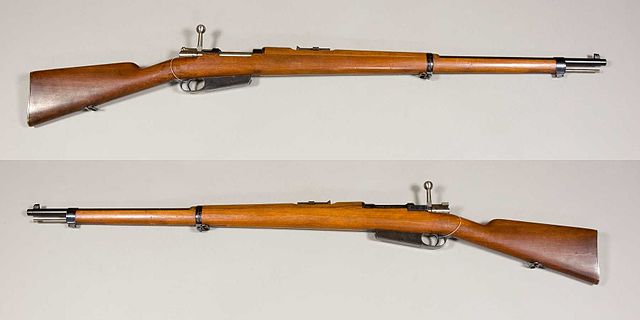The 7×57mm Mauser is a first-generation smokeless powder rimless bottlenecked rifle cartridge. It was developed by Paul Mauser of the Mauser company in 1892 and adopted as a military cartridge by Spain in 1893. It was subsequently adopted by several other countries as the standard military cartridge, and although now obsolete as a military cartridge, it remains in widespread international use as a sporting round. The 7×57 Mauser was a popular stalking cartridge and sporting rifles in this chambering were made by the famous British riflemakers, such as John Rigby, Holland and Holland, Westley Richards and others. British cartridge nomenclature designated caliber in inches, and the cartridge was known as the .275 bore after the measurement of a 7 mm rifle's bore across the lands. The cartridge is sometimes erroneously referred to as the ".275 Rigby", However, the original John Rigby & Sons never referred to the cartridge by that name, nor did any of UK gun trade; the Rigby association is a misconception attributed to modern American gun writers.

Two 7×57mm cartridges next to a 7.5×55mm/GP11 (mid), .308 Winchester and .223 Remington (far right)
A modern 7 mm Mauser cartridge next to two 7.92 mm Mauser cartridges (FMJ round nose and spitzer bullets)
7×57mm hunting cartridge
Image: 7 x 57
Mauser, originally the Königlich Württembergische Gewehrfabrik, was a German arms manufacturer. Their line of bolt-action rifles and semi-automatic pistols was produced beginning in the 1870s for the German armed forces. In the late 19th and early 20th centuries, Mauser designs were also exported and licensed to many countries, which adopted them as military and civilian sporting firearms. The Gewehr 98 in particular was widely adopted and copied, and it is the foundation of many of today's sporting bolt-action rifles.
Mauser Model 1871 rifle
Mauser Experimental Model 92 in caliber 8x58R. This rifle took part in the rifle trials that led to the Swedish Mauser.
Swedish carbine Model 1894
Swedish rifle Model 1896








